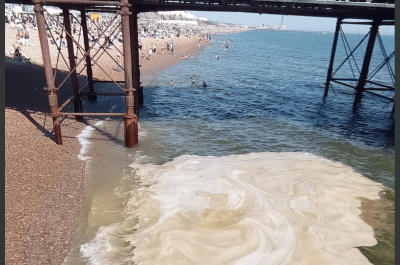
If you see sludgy-looking stuff with an unpleasant smell on parts of the beach, don’t panic! This is an algal bloom, a natural occurrence when the sea warms up, prompting tiny organisms called algae to reproduce rapidly.
The algal bloom season typically lasts about four weeks before it dissipates. While it might be easy to mistake these blooms for sewage due to their unpleasant smell, they are entirely harmless.
Algal blooms can be identified by foam on the water’s surface or on the beach. This foam is more likely the result of an algal bloom breaking down rather than sewage. Throughout the summer months, large blooms of Phaeocystis, a common and non-toxic algae, form in British coastal waters when temperatures rise and there’s more sunlight. These blooms are a natural part of water ecology. When they accumulate, especially in early summer, they produce colonies that look like frog spawn or oil drops in the water.
As these blooms begin to break down, they can emit a smell similar to rotten eggs or vegetables, which is also common with decomposing seaweed. This process can create creamy-brown foam on the water’s surface. Near cliffs or headlands, this foam may appear as thin layers or lines due to wave action, and in exceptional cases, can form thick blankets along the shoreline.
Another non-toxic marine algae that can be found in these waters is Noctiluca, known for causing red, orange, or brown discoloration of the water, referred to as ‘red tide’. Noctiluca can also produce a scum and is bioluminescent, earning the nickname ‘sea sparkle’ due to the light it emits through a chemical reaction.
A literature review and recent guidance from the World Health Organization suggest that the risks to human health from contact, ingestion, or inhalation of marine algae currently found in UK coastal waters are considered to be low. Therefore, while the appearance and smell of algal blooms may be off-putting, they pose no significant threat to beachgoers.



